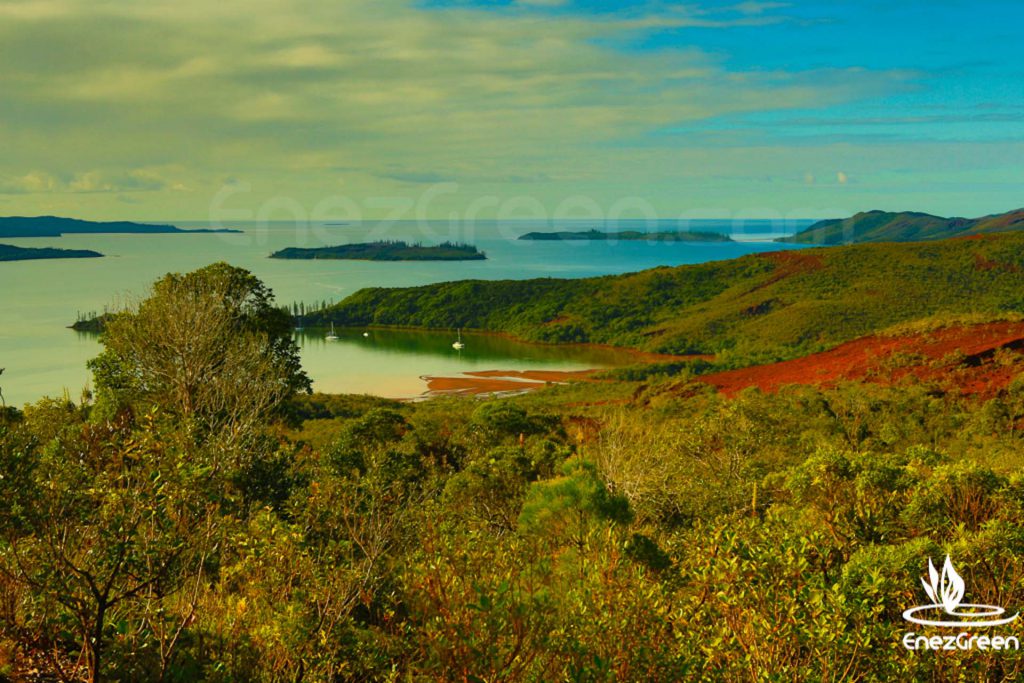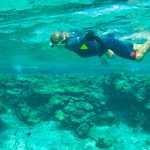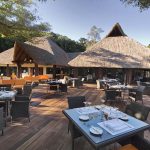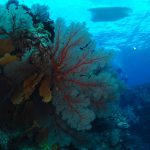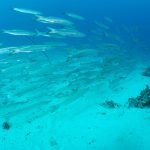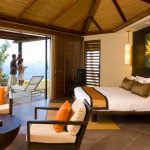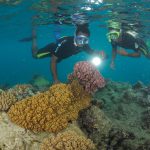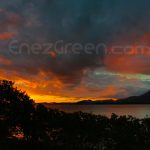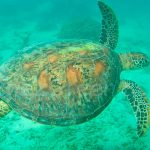Heavenly and diversified landscapes
New Caledonia is located 1,500 km away from Australia and is the third-biggest island in the Pacific.
The main island is Grande Terre and the archipelago also comprises the Loyalty Islands to the east, Pine Island to the south and the Belep Islands to the north. While the islands present heavenly scenery, Grande Terre has an extremely diversified landscape. The southern part of the main island features red earth and a plain of lakes in the south. The western coast is arid with bare plains and ‘niaouli’ savannahs. The eastern coast is covered with lush vegetation and a humid forest while the central part of the island comprises valleys, rivers and forests.
The coral reef of New Caledonia is a hot spot of world biodiversity and is the second-largest barrier reef in the world, with some 15,000 km2 divided into six sites are included on the UNESCO World Heritage sites list. In some place, one can even see double or triple barrier reefs, which is really remarkable knowing that there are less than ten of these in the world!
General climate
The tropical ocean climate is tempered by trade winds.
The hot season stretches from November to March with temperatures between 22 °C and 31 °C, while the cool season starts in April with temperatures between 15 °C and 26 °C.
Cyclones and storms accompanied by torrential downpours are most common from December to April.
Air and sea temperatures in the archipelago average 29 °C and 25 °C respectively in January and 29 °C and 26 °C in February.
New Caledonian fauna and flora
The fauna and flora of New Caledonia have been cut off from the world for 30 million years and the archipelago is blessed with a remarkable biodiversity as well as the highest rate of endemism in the world.
The Caledonian forest on its own counts over 2,500 endemic plant species and is considered as the ‘first botanical garden of the South-Pacific’.
The Institute for Research and Development (IRD) has identified more than 20,000 marine species with a number of rare seashells and living fossils, including the famous Nautilus shell, which has barely evolved in 400 million years.
Local institutions and authorities are concerned with the preservation of natural and cultural sites and have adopted strict protection measures. Natural reserves have also been set up to protect the most vulnerable zones and avoid the extinction of endangered species such as the sea turtle, the dugong or the cagou — the latter, a peculiar wader which barks and runs around, is the national bird of New Caledonia.
The reefs and the lagoon, a UNESCO World Heritage Site
The coral reefs of New Caledonia are in an excellent state of conservation and are considered a hot spot of the planet’s biodiversity by the international community.
They have been included on the UNESCO list of World Heritage Sites in July 2008. The project for the site to be included on the UNESCO list was launched in 2001 by local environmental protection associations and was subsequently supported by the Provincial Assemblies, the Government of New Caledonia and the Customary Senate. Their support was imperative to ensure the success of the endeavour.
Six sites that are representative of the coral reefs of New Caledonia have been included on the list. This serial property proposed to the UNESCO under the heading: ‘Lagoons of New Caledonia: Reef Diversity and Associated Ecosystems’ comprises over 15,000 km2 of lagoons and reefs, i.e. 60% of the lagoons of Grande Terre and the Loyalty Islands.
This inclusion is seen as a major step forward for the destination and reinforces the international recognition of the remarkable value of its lagoons and coral reefs. Moreover, this will enhance awareness among the locals of the need to protect the marine environment and to adopt a sustainable development approach that is acknowledged and supported at international level. Finally, it is an opportunity to position New Caledonia as a nature destination that promotes ecologically responsible tourism.
An initiative to protect sharks under way
On 18 February 2009, the Provincial Assembly of the South Province has adopted a bill that was meant to list sharks among endangered species and ban finning (the removal and retention of shark fins).
But at the last minute, sharks were removed from the list of protected species!
This turnaround has caused the indignation of the Longitude 181 NATURE association, speaking on behalf of thousands of divers and sea buffs, and has given rise to a petition.
A whale sanctuary
An estimated 300 to 600 humpback whales transit in the waters of New Caledonia between July and October.
Since 2003, the Congress of New Caledonia has established a whale sanctuary that covers its exclusive economic zone. The South Province has recently extended this sanctuary to all sea mammals, namely dolphins and dugongs, in waters under its authority.
A leaflet on the proper approach to whale watching has been published by the Directorate of Natural Resources of the South Province.
Renewable energies
In the recent few years, solar energy has become very popular in New Caledonia, with an increasing number of solar water heaters and solar panels. The most secluded zones of New Caledonia can thus have access to electricity.
The ADEME (French Agency for the Environment and Energy Management) in involved in helping to solve environmental issues in New Caledonia since 1995. In 15 years, 1,500 photovoltaic structures, 50 photovoltaic pumps, 2,500 solar water heaters, 4 eolian structures and 13 hydroelectric structures have been installed.
According to this organisation, the archipelago will have, in the near future, a true technological show window in terms of photovoltaic and eolian energy.
Nautical events in New Caledonia
New Caledonian Nautical Club, section ‘Alizes’
The ‘Alizes’ section of the New Caledonian Nautical Club (CNC) regroups sailing buffs among the club’s 1,700 members.
This autonomous section holds a series of regattas in inhabitable sailboats that are open to all between February and December. The programme comprises gatherings among die-hard regatta lovers as well as a concentration of sailboats.
The atmosphere is more festive than competitive with barbecues on islets and in bays. The section also holds deep sea regattas like the Noumea-Port Vila race in 2007 or the Whangarei-Noumea and the Noumea-Brisbane races a few years back.
Auckland-Noumea deep sea race
Last year, the famous deep sea race to Auckland, held by the Fiji Islands in 2005 and 2006, then by Port Vila in 2007 and again by the Fiji Islands, came back to the lagoons of New Caledonia after five years.
The departure was scheduled on 27 June 2009 at 2 pm. The 70-hour record mark is held since 2004 by New Zealand super maxi, Zana.
The CNC has registered 25 participants for this race, including some boats drawing up to 4 metres of water. Three Caledonian sailboats were enrolled in the race.
East-West round New Caledonia sailboat race
The first edition of the East-West round New Caledonia sailboat race was held between 13 and 19 September 2008 and it is fast becoming a reference among sea races. A memorandum of understanding has been signed between the CNC and French bank and insurance company Groupama, with the endorsement of French navigator Franck Cammas.
Participants must sail 600 miles and set a reference time. Noumea is the departure and arrival point of this race, with two compulsory turning points, namely Cape N’Dua to the south and the northeastern tip of the Grand Passage.
All inhabitable boats with an ORC Club tonnage certificate can take part in the race.
There are three types of ranking: monohulls in real time, monohulls in corrected time and catamarans in real time.
The first edition of the Groupama Race was won by Caledonians: in corrected time, ‘TFO les Huitres de Dumbea’ ranked first ahead of ‘Team Australia les Nouvelles’ and ‘Team New Zealand’, which have taken part in various transoceanic races as well as the prestigious America’s Cup.
Beneteau – Lagoon Cup Noumea-Port Vila
The Beneteau Lagoon Cup regatta between Noumea and Port Vila departed on 5 September 2009. Held in collaboration with French boatmaker Beneteau, the Beneteau Cups are convivial events open to all leisure craft owners.
The Pine Island Regatta in Solo/Duo
This race was held on 1 May 2009. The reference time in duo for the Noumea/Kuto/Noumea trip is 17hrs49m21s, with an average speed of 7 knots.
Axxess Travel Grand Prix
The Axxess Travel Grand Prix took place between 21 February and 9 August 2009. Held for the first time in New Caledonia, this multiple-regatta race is open to Elliott 5.9 sports boats and is held on equal terms.
The race is open to any 4-people crew aboard boats provided by the organisers.
Last year, 15 crews contended for the title, including 2 all women and 2 all-youth crews. The winners had the chance to represent the archipelago in the National Keelboat, in New Zealand.
Hobie Cat 16 Championship of New Caledonia
The Hobie Cat 16 Championship of New Caledonia takes place over two consecutive weekends in the bay of Sainte-Marie. The 15th Hobie Cat 16 World Championship was organised between 1 and 13 April 2002 and was the most important regatta to ever take place in New Caledonia. Since 2001, the last leg of the Kiteboard Pro Tour is held in New Caledonia, after which the world champions in the discipline are crowned.
The championship takes place on the stretch of water of the Meridien Noumea beach with a speed crossing event to the Amedee lighthouse.
Great Lagoon Regatta
The Great Lagoon Regatta is a new sailing race organised in the fantastic New Caledonian lagoon. This three days race allowed twenty boats
Maritime facilities overview
New Caledonia counts a number of marinas offering the best comfort conditions to pleasure crafts – from the super yacht to the tiniest of crafts – alongside the quay or at moorage in Noumea, We (Lifou), Hienghene or Koumac…
The marinas in Noumea are located a short distance away from the market, restaurants, Internet cafés, the post office and other attractions.
Port Moselle is the most important yachting harbour of Noumea and of the whole territory. It is the port of entry and a port of call in New Caledonia. All pleasure crafts must berth in Port Moselle upon arrival to complete the formalities at the harbour master’s office, customs and immigration services to be allowed in the harbour.
The 17 floating landing stages of the New Caledonian Nautical Club can accommodate 620 boats. Facilities available comprise a clubhouse with a bar, a pub and restaurant, a careening area and an elevator.
The club hosts deep sea races from neighbouring countries to Noumea. It also holds races in the lagoon, big-game fishing contests and evening parties.
Some 10 rental companies holding the professional quality certification offer an array of sailboats, monohulls or catamarans, as well as motorboats with or without skipper. These boats are equipped with all the modern comfort and are suitable for navigation in all safety in the lagoon or in the open sea to moor around the islets or in the bays.
One- or multiple-day charter outings are also offered by NUC (boats for collective transport) classified boats complying with professional security standards and steered by a qualified crew or skipper. A professional and experienced crew provides visitors with an ideal solution to discover in all serenity the most beautiful mooring sites of the archipelago.
Exploitation of the maritime domain
The exclusive economic zone of New Caledonia stretches over 1,450,000 km2, i.e. half the surface area of the Mediterranean Sea. Professional fishing in the archipelago comprises three distinct fields of activity.
Lagoon fishing is undertaken within the lagoon and its produce (sea cucumbers and shell fish) is sold on the local market and exported to Asian countries.
Coastal fishing is undertaken outside the lagoon. The deep-sea fish and pelagic fish caught in the territorial waters are sold on the local market.Finally, deep-sea fishing is practised in the exclusive economic zone using longliner boats. The catches, which consist of white and yellow tuna, marlins, shortfin mako sharks and swordfish, are mainly exported to Europe and Japan.
Leisure fishing and fishing for self-reliance are mostly practised within the lagoon and the yearly catch is evaluated at 3,500 tonnes.
The fish farming sector mainly focuses on prawn culture, which started in the early 1980s following research work undertaken by the IFREMER (French Research Institute for Exploitation of the Sea) to determine the most appropriate prawn species as well as reproduction and farming techniques. The activity actually ranks second among Caledonian exports. During the 2006–2007 campaign, 19 farms with a total surface area of 640 ha produced 1,800 tonnes of prawns.
Cultural highlights of the destination
The population of the archipelago is as diverse as its scenery. It comprises Kanaks (Melanesian people), Caledonians (descendants of European colons also called ‘Caldoches’, people from mainland France – called ‘Z’oreilles’ – , Europeans as well as people of Wallisian, Polynesian and Asian origins – nearly 246,000 inhabitants living together on the same piece of rock.
The Kanak people have Austronesian ancestry and settled in the archipelago some 3,000 years ago. They represent less than 44% of the population.
There are more than 30 Kanak dialects and respect for tradition is part of the daily life of the people. They still follow their usual custom and courtesy remains very much alive among the people, whether they live in the bush or in the islands.
When different tribes visit each other, they carry on the custom of offering a little gift to the chief – a pareu, cigarettes or banknotes… – as a mark of respect.

